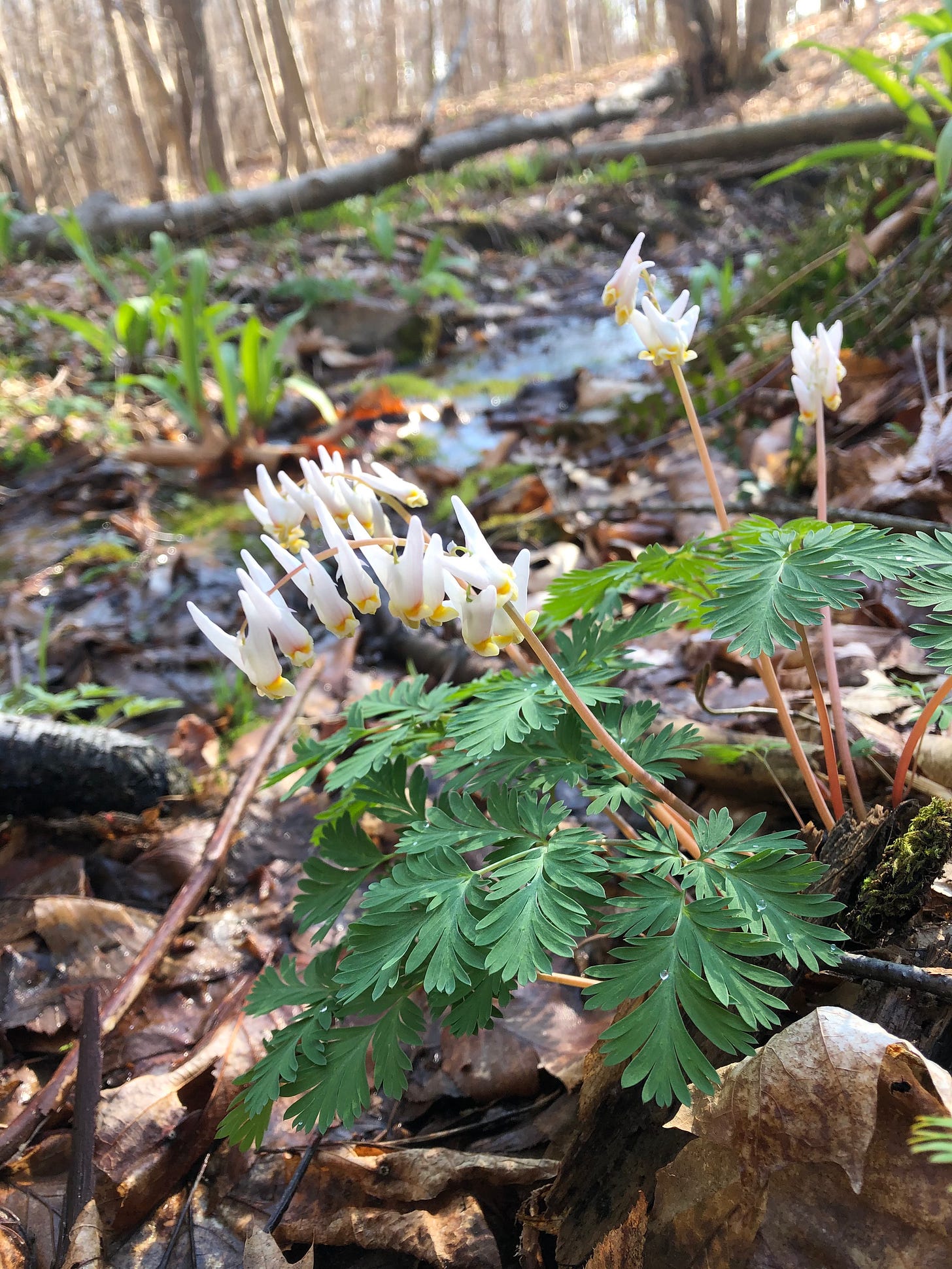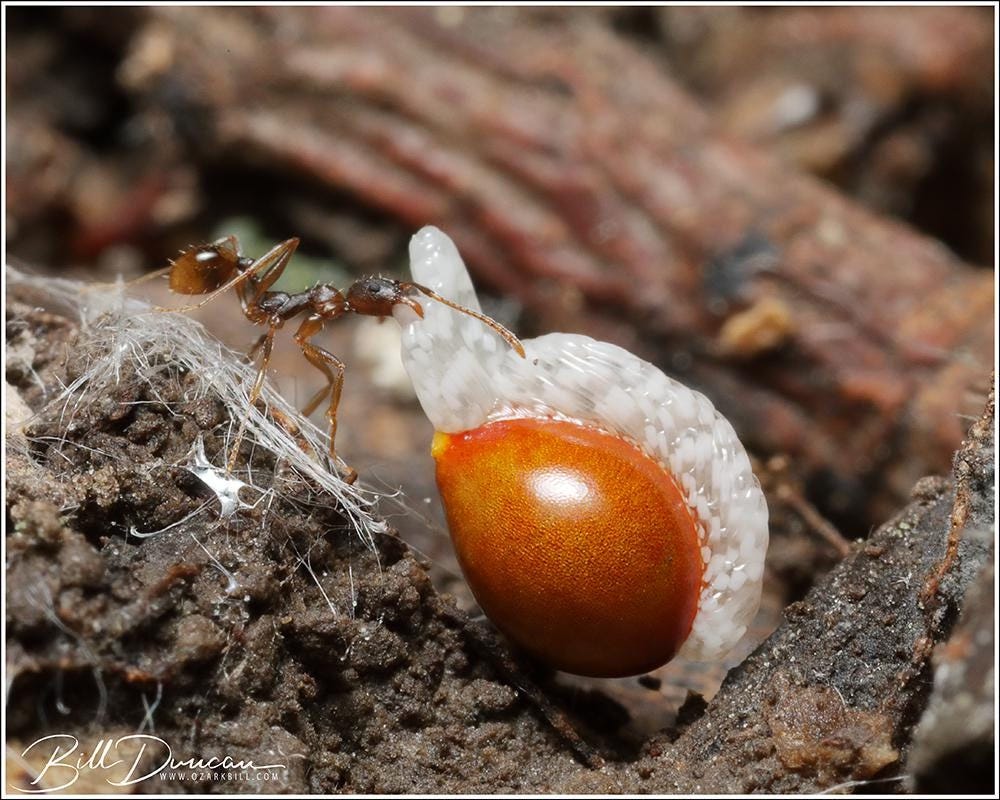It’s time, it’s here! The spring ephemerals are finally blooming. I keep thinking about my explanation a few newsletters ago about chopping up the spring into little seasonal slivers and, I have to admit, this one is above and beyond my favourite. This year I am getting to partake in it twice after my dip down into the south 2 weeks ago where I got to see Toad Trilliums and Squirrel Corn and Bluebells—species we just don’t have here in NY. A very lucky me!

So, what makes something “an ephemeral”? I think there’s a little flexibility here as to who exactly falls into the category, but, as the name suggests, these flowers are usually fleeting and they bloom in the early days of spring. I think it’s useful in the explanation to harken all the way back to what the point of a flower is, just as a little reminder. Flowers are the reproductive organs of a plant. A massive tree can have (and usually does) a teeny tiny, almost unrecognizable flower and a tiny plant can have something large and garish and colourfully gaudy. No matter the size or shape, their function is the same—to be pollinated in some way, to make seed, and then to spread it around in order to reproduce. All the other parts of a plant, for the most part, function to gather nutrients—the roots from the soil and the leaves from the sun. There are plants that don’t flower—ferns, for instance, are spore-producing, but that’s a story for a different time.

Blooming takes energy! Some plants bloom first, using their stored up winter reserves, and then spend the rest of the growing season soaking in the sunlight and water. Others photosynthesize for a while first and bloom further on down the line. Each plant has their moment and, unless something wacky is happening, that moment is the same time each year, adjusted only for weather and climate differences.
Spring ephemerals are, typically, forest floor dwellers (though some creep out into open spaces too, like Bloodroot) that bloom in the early days of spring when the trees do not yet have their leaves and the forest canopy still lets in ample light. They are small and delicate and many of them bloom for just a few short days. To me, they turn the woods into a magical fairy land and it is something not to be missed.
Something I’ve been thinking about a lot and something I love so much about nature is the mysterious unknown of it all. Sure, there’s science and I do love scientific explanation, but I also very much enjoy wondering, just to wonder and never to know. And for many things in the natural world, explanation is kind of a loose term—can we ever really know why something is there or does what it does? It’s such a human and, frankly, a white supremacist mode of thinking to believe everything has a purpose that makes sense or falls in line with our own world view. To think everything has a purpose that involves us! What is the purpose or function of the spring ephemerals other than to be beautiful and turn the forest floor into a carpet of colour and joy? I honestly don’t care beyond knowing that some people need that sort of thing to give it value.
I’ve also been thinking about ants. Yes, ants! Among other insects who rely on the various plants for survival. The other day I saw the Spricebush trees blooming and was reminded that this shrub (and its Laurel family brethren) have a specialized butterfly that relies upon it for survival—the Spicebush Swallowtail. But the ants are an especially fascinating one to me. Usually seen as pests, we rarely talk about them as pollinators of sorts or, more accurately, vehicles for plant dispersal. And this is very crucial when we talk about ephemerals!

Myrmecochory is the name for the mutualistic partnership certain plants have with ants and it fascinates me. These plants evolved to have a fatty structure attached their seeds that ants, in particular, love, called an elaiosome—which essentially means “oil body”—that contains a mixture of fats, proteins, and carbohydrates, making it delicious. The ants come to eat this nutrient-rich treat and by way of doing so, take the seeds along with them. Ants are communal creatures, so they gather food not just for themselves but for the collective (Socialism! And something to admire + emulate, no?) and return to the nest to share their delicacy discoveries. They eat the elaiosome then discard the leftover seed in their trash heap, really a glorified compost pile rich in nutrients, which then nurtures and protects the seed as it grows, allowing these plants also to spread further and further away.
There are about 11,000 plant species in the world that rely on this symbiotic ant relationship for seed dispersal and germination. In our North American deciduous forest, this equates to about 1/3 of our understory plants, including many, if not most, of our beloved spring ephemerals: Bloodroot (Sanguinaria canadensis Papavaraceae), Trillium (in our case here in the hudson valley, Trillium erectum Ranunculaceae), Dutchman’s Breeches (Dicentra cucularia Papavaraceae), Trout Lily (Erythronium americanum Liliaceae), and Wild Ginger (Asarum canadense Aristolochiaceae), just to name a few!

While I am more on the plant side of things, I want to adequately celebrate the ants. How cool are they?! Insects are so easily folded into that line of questioning where we ask “what’s the point of them?” because they can be freaky or bothersome or frustratingly enter the home in excessive numbers (like ants). But a lot of these tiny creatures have massive and positive impacts on the greater environment. Ants, for instance, are even seen by many as a keystone species—an organism that holds an entire ecosystem together—because of the major influence they have on the soil and both plant and animal life. And when a more readily understandable purpose is hard to find, there is always indigenous perspectives to look to that add a little myth and magic (often rooted in practicality) that provide answers when the more pragmatic science (AKA white) approaches fail us. As a related example, here’s a link to a Doug Elliot story based on an indigenous tale about mosquitoes.
And a great video describing the myrmecochory process with exciting footage of the ants in action!
I encourage you to get out into the woods this week and next (that’s where I’m headed after I hit send!) to spy some of these beautiful evanescent flowers before they are gone and I hope you think, too, of the ants underfoot, the creatures who make the whole thing happen.
xx hannah
Also, I’ve made a little change to this newsletter—it has a title now! I’m calling it In the leaves :) And while I write just to write and to share the things I am excited about, sometimes it truly does feel like I’m shouting into the void. Is anyone reading this? Am I writing enough? Am I writing too much? Do the people care? I am not immune to self doubt. Leave a comment! Tell me what you think! Like the posts you love! Share it with a friend! Grateful for your readership as always <3
And don’t forget about Nettle Day!!!!! Read more & register here.








I’m reading it and I do care!! ✨🌞
I love this! The ephemerals feel like such a gift. Thank you for sharing this - and do keep writing about what moves you!